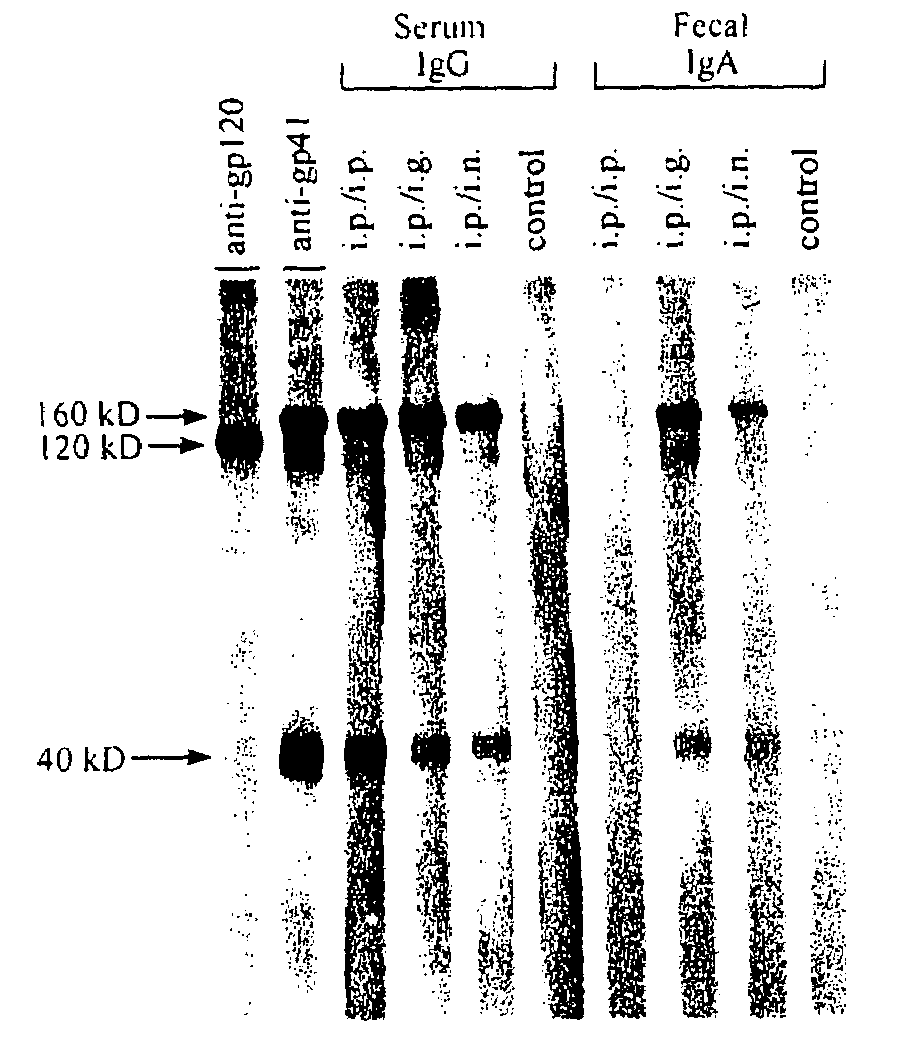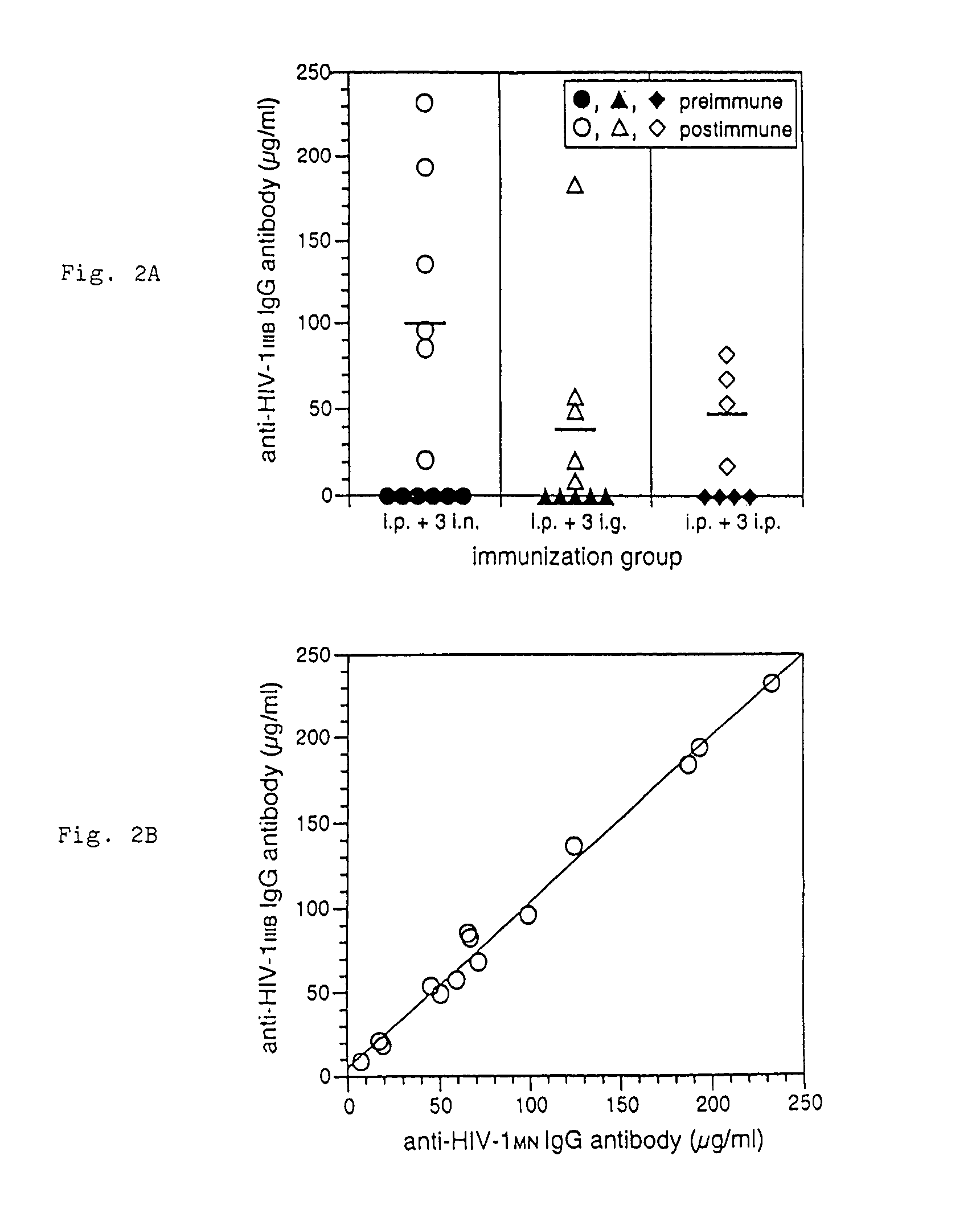Fusion protein construct and method for inducing HIV-specific serum IgG and secretory IgA antibodies in-vivo
a technology of fusion protein and serum igg, which is applied in the field of immunological antibodies, can solve the problems of large proportion of hiv infections, mucosal immunization, and inability to detect mucosal secretory antibodies in animal experiments and human trials, and achieve the effect of preventing viral transmission and positive correlation
- Summary
- Abstract
- Description
- Claims
- Application Information
AI Technical Summary
Benefits of technology
Problems solved by technology
Method used
Image
Examples
experiment 1
Systemic and Mucosal Immunogenicity of gp41HA
[0143]To test whether the recombinant gp41 protein gp41HA is immunogenic in mice when used in a systemic prime / mucosal boost regimen, groups of mice were primed intraperitoneally (i.p.), then boosted either i.p., intranasally (i.n.) or intragastrically (i.g.) three times at two-week intervals, as described in the Materials and Methods. Serum and fecal extracts were collected 7 and 10 days after the last immunization and screened by ELISA for reactivity to gp41HA antigen.
[0144]Antibody levels in fecal extract can serve as an indicator of secretory antibodies in the gastrointestinal tract of mice. The average reciprocal endpoint titer of gp41HA-specific IgG in sera of mice in all immunized groups exceeded 600,000 on day 7, whereas reciprocal endpoint titers in pre-immune sera or unimmunized controls were less than 100 (data not shown). High levels of anti-gp41HA IgA antibodies were detected in fecal extracts collected on day 10 from i.n. an...
experiment 2
HIV-1 Specific IgG in Serum of Systemically and Mucosally Immunized Mice
[0145]Because gp41HA is a recombinant fusion protein containing portions of both HIV-1 gp41 and influenza HA, the gp41HA ELISA data of Experiment 1 did not indicate whether gp41-specific antibodies were induced in these animals. Therefore, in this experiment, the serum samples were analyzed by ELISA for reactivity to gp41 in HIV-1IIIB viral lysate. The empirical results are shown graphically by FIGS. 2A and 2B respectively.
[0146]FIG. 2 as a whole demonstrates that HIV-specific IgG antibodies are induced in serum. FIG. 2A shows geometric mean (bars) and individual concentrations of anti-HIV-1IIIB IgG antibody quantitated by ELISA in serum of mice before immunization and 10 days after the last immunization with gp41HA. FIG. 2B shows the concentrations of anti-HIV-1IIIB and anti-HIV-1MN IgG antibodies measured in day 10 serum of all immunized mice. Geometric mean concentrations of anti-HIV-1IIIB IgG in preimmune se...
experiment 3
Levels of Anti-HIV-1 Specific IgA Antibodies in Fecal Extracts
[0149]To determine whether systemic prime followed by mucosal boosts with gp41HA induced mucosal IgA antibodies to gp41, fecal; extracts from immunized mice were examined by ELISA for IgA antibodies to HIV-1IIIB viral lysate. Because an anti-gp41 monoclonal IgA standard was not available, the concentrations of anti-HIV-1IIIB IgA antibodies were estimated using as a standard the anti-gp41 IgG monoclonal antibody described above. In interpreting these results, one is aware of the fact that intestinal IgA antibodies are generally in dimeric (or oligomeric) form; and consequently, it is likely that concentrations of specific IgA were underestimated by a factor of 2.5 when using an IgG standard.
[0150]Postimmune fecal extracts from mice in the i.p. / i.n. and i.p. / i.g. immunization groups both demonstrated mean reciprocal endpoint titers of 220 and mean concentrations of 6 g / ml anti-HIV-1IIIB IgA antibody. It is known that total ...
PUM
| Property | Measurement | Unit |
|---|---|---|
| temperature | aaaaa | aaaaa |
| pH | aaaaa | aaaaa |
| pH | aaaaa | aaaaa |
Abstract
Description
Claims
Application Information
 Login to View More
Login to View More - R&D
- Intellectual Property
- Life Sciences
- Materials
- Tech Scout
- Unparalleled Data Quality
- Higher Quality Content
- 60% Fewer Hallucinations
Browse by: Latest US Patents, China's latest patents, Technical Efficacy Thesaurus, Application Domain, Technology Topic, Popular Technical Reports.
© 2025 PatSnap. All rights reserved.Legal|Privacy policy|Modern Slavery Act Transparency Statement|Sitemap|About US| Contact US: help@patsnap.com



